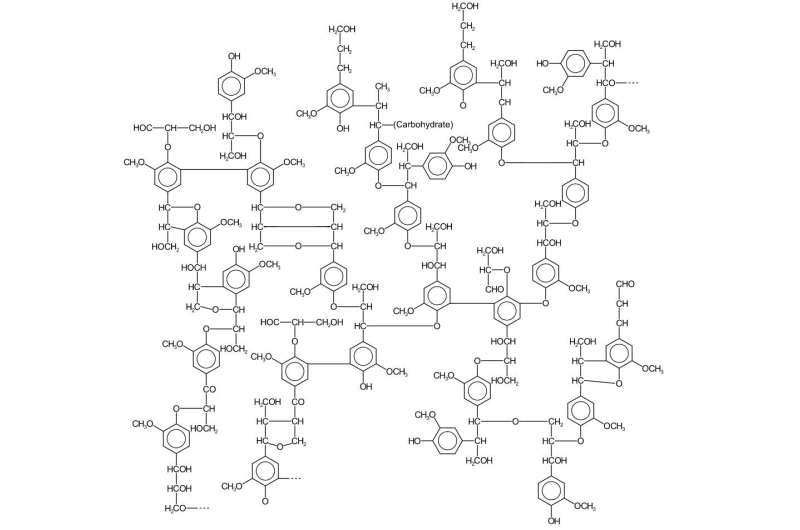Researchers isolate new types of microorganisms that cleave ether bonds in lignin-based compound

Lignin, a chief component of cell walls in plants, is naturally degraded in the soil. Identifying new microorganisms involved in this degradation can help develop novel lignin breakdown processes in industrial settings. Now, researchers from Tokyo University of Science have isolated eight microorganisms that degrade the lignin model compound 2-phenoxyacetophenone (2-PAP). They found that one of these microbes uses a new, unidentified enzyme to cleave the ether-bonds in 2-PAP, resulting in the formation of phenol and benzoate.
Like all known life forms, plants have a body made of organic matter, including cell walls made of various components including lignin, a heterogenous polymer. Lignin is the second-most abundant organic substance on Earth, with great potential in the production of industrial chemicals, such as aromatic compounds.
Chemically, lignin is made up of multiple subunits linked by "ether" and "carbon-carbon" bonds, all of which need to be broken down for lignin decay. It is well known that microorganisms cleave ether bonds effectively through the production of extracellular enzymes, which aid in lignin degradation. Two microbes that perform this degradation were identified: white-rot fungi through the production of peroxidases and laccases, and Sphingomonad bacteria with the help of intracellular enzymes.
These discoveries sparked curiosity among a team of researchers, including Dr. Toshiki Furuya and Ms. Saki Oya from Tokyo University of Science, and Dr. Hiroshi Habe from National Institute of Advanced Industrial Science and Technology in Tokyo, on whether there are additional, unknown microorganisms that degrade lignin through different enzymes. Identifying these microorganisms and finding out how they degrade lignin could enhance the overall understanding of the carbon cycle and facilitate the biotechnological applications of these microorganisms for lignin commercialization. The team also realized that none of the previous studies have focused on how microorganisms transform or degrade 2-PAP.
To find an answer to these questions, Dr. Furuya and his team conducted a study, published in Scientific Reports, to screen microorganisms that utilize new ether-bond cleaving enzymes to transform 2-PAP. The team initially used a direct screening method to isolate microorganisms from soil based on their ether-bond cleaving activity, by growing them on a medium containing humic acid, a soil-derived organic compound, as a carbon source. Next, they incubated the isolated microorganisms with 2-PAP to check specifically for 2-PAP ether bond-cleaving activity. The bond cleaving activity was confirmed depending on the presence of phenol, which is generally produced as a result of ether-bond cleavage.
This led to the isolation of not one, but eight 2-PAP-transforming microorganisms. These included seven bacteria from the genus Acinetobacter, Cupriavidus, Nocardioides, and Streptomyces, and one fungus from the genus Penicillium. "To our knowledge, these are the first microorganisms demonstrated to cleave the ether bond of 2-PAP," Dr. Furuya emphasized, when asked about these discoveries.
Among the isolated microorganisms, the team examined a gram-negative bacterium, Acinetobacter sp. TUS-SO1, in detail and discovered that it selectively and oxidatively cleaves ether bonds in 2-PAP, to produce phenol and benzoate. This was especially surprising, because β-etherase, a well-studied enzyme known to perform this cleaving, gives phenol and acetophenone. This implies that this bacterial strain cleaves the ether-bond of 2-PAP using an unidentified enzyme.
When asked about the implications of these findings, Dr. Furuya says, "These newly identified microorganisms might play important roles in the degradation of lignin-based compounds in nature. By clarifying the properties of these microorganisms, we can apply them to lignin-based compounds for the generation of aromatic compounds, as an alternative to petroleum. Moreover, they can be utilized for lignin valorization, especially for the conversion of low-molecular-weight compounds that have chemical structures similar to 2-PAP."
How is the technique for the identification of lignin-degrading microorganisms useful in the long run? According to the authors, this established search technology can be widely applied to search for microorganisms that exhibit cleavage activity against other ether compounds, such as environmental pollutants.
These discoveries are indeed exciting and can lead to developments not just in industries that use lignin, but also in mitigating the effects of environmental pollutants.
More information: Saki Oya et al, Isolation and characterization of microorganisms capable of cleaving the ether bond of 2-phenoxyacetophenone, Scientific Reports (2022). DOI: 10.1038/s41598-022-06816-1
Journal information: Scientific Reports
Provided by Tokyo University of Science



















